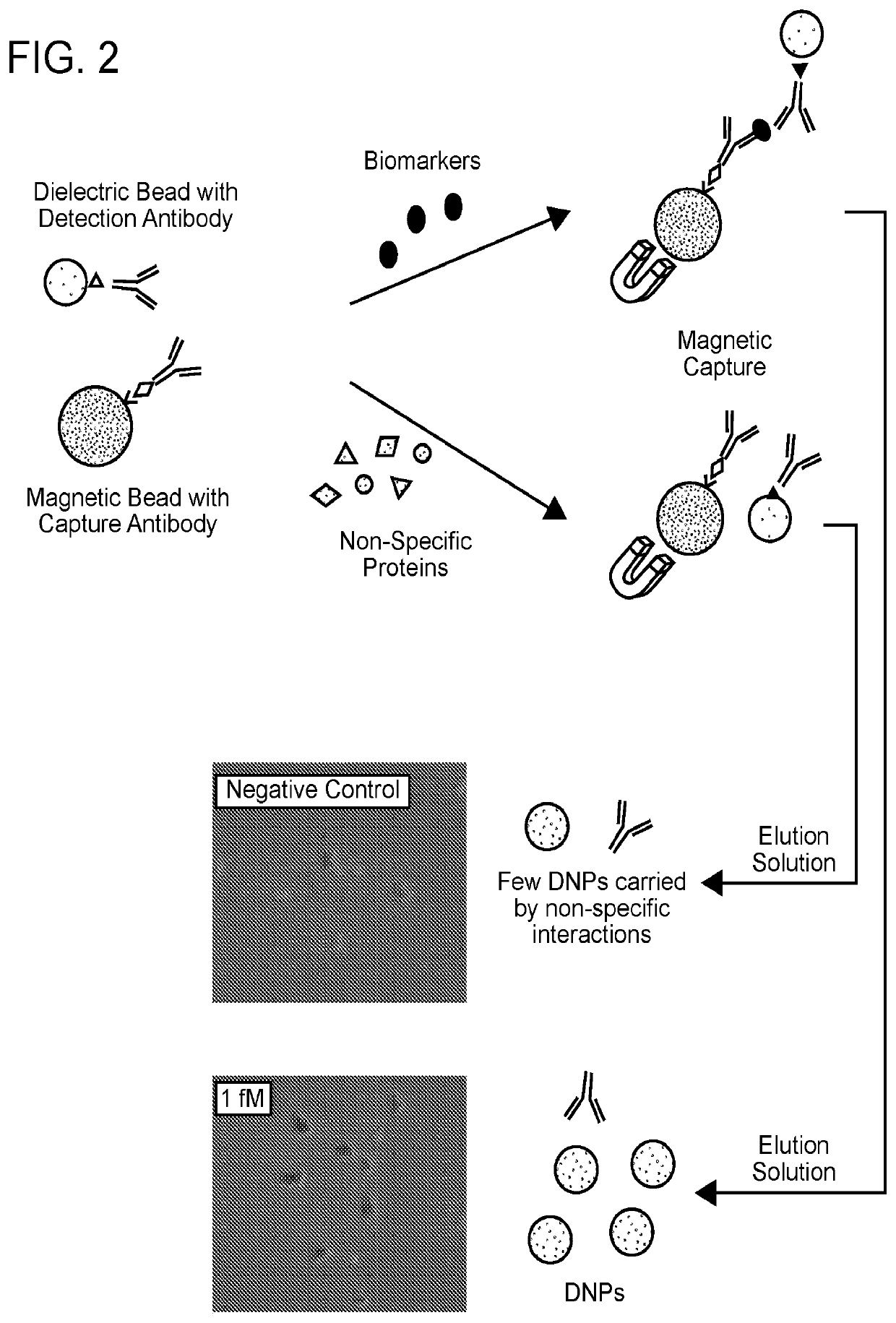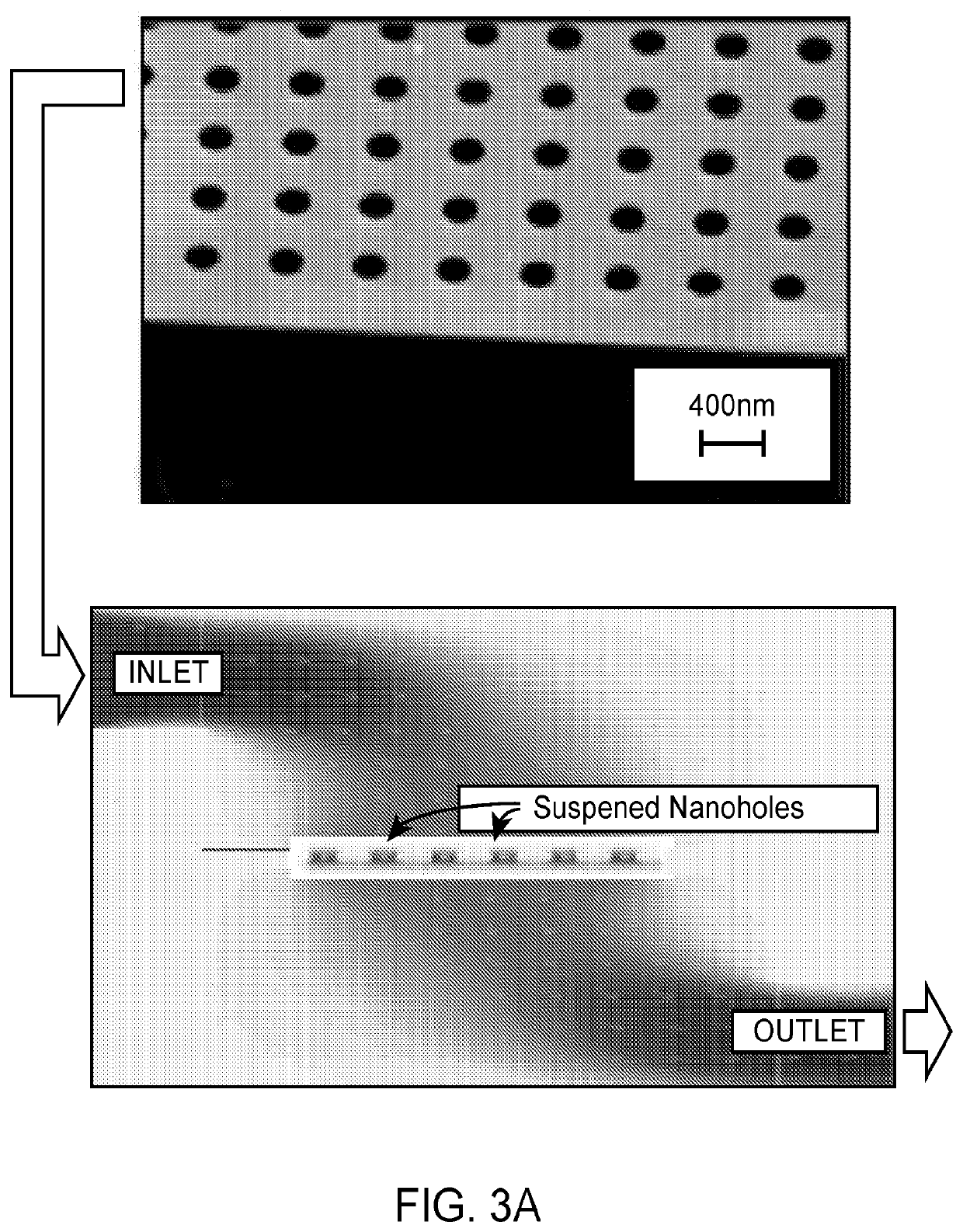Detection of target analytes at picomolar concentrations
a target analyte and concentration technology, applied in the field of detection of target analytes at picomolar concentrations, can solve the problems of long incubation time, complicated experimental operation procedures, and impede detection and monitoring of disease progression or recurrence,
- Summary
- Abstract
- Description
- Claims
- Application Information
AI Technical Summary
Benefits of technology
Problems solved by technology
Method used
Image
Examples
example 1
n of Nanofluidic Enrichment and Conventional Microfluidics
[0132]An elution solution comprising 200 nm dielectric beads at a concentration of 108 beads / ml was run through the nanohole array at a rate of 10 μl / min (FIG. 3B). Optimal accumulation of the dielectric beads was observed using a vertical flow scheme involving nanohole openings projecting through suspended membranes. When the same solution was allowed to run through the channel using a conventional flow scheme (flow over)—where the elution solution follows parallel to the surface—less accumulation of the nanoparticles was observed. These results indicate that it is easier to capture the beads at high efficiencies on channel walls using vertical flow.
[0133]In another experiment, the biomarker (target analyte) detected was prostate specific antigen (PSA).” In addition, “biomarker-to-bead conversion” is interchangeable with “biomarker-to-bead transformation” or “B2B conversion” or “B2B transformation.”) FIGS. 9A-9C illustrates ...
example 2
tection of Biomarkers Due to Resonance Shift
[0138]A metal (Au) film of about 120 nm in thickness with a pitch length of about 500-700 nm was used. The film also included nanohole array (NHA) sensors—a periodic array of suspended sub-wavelength nanoapertures (holes with diameters of about 150-250 nm). Spectral responses upon accumulation of dielectric beads could be observed using three-dimensional (3-D) Finite Difference Time Domain (FDTD) electromagnetic simulations. The film was designed to be optically thick and the nanoapertures of such a diameter that they were too small to transmit light. Thus, incident light could then only be transmitted at specific resonant wavelengths via an optical process incorporating surface plasmon polaritons (SPPs). Biomolecules / pathogens binding to the metallic nanohole surfaces increased the effective refractive index of the medium around the nanoholes, which led to red shifting of the plasmonic resonances. Furthermore, measurement of the Fano reso...
example 3
-to-Bead (B2B) Conversion
[0144]B2B conversions were performed as outlined in FIGS. 1 and 2.
[0145]Visual detection was demonstrated for target analyte concentration of 15 pM. A commercial ELISA kit (CMC4033, Thermo Fisher Scientific) was used for comparison. Initially, a mouse anti-IFN-γ antibody (6 μg / ml) was incubated with Superparamagnetic Dynabeads (2.8 μm diameter, 0.75 mg / ml concentration-Thermo Fisher Scientific) for surface conjugation. After a magnetic wash and resuspension, the antibody-conjugated magnetic bead solution was mixed with 10 μL stock solution containing mouse IFN-γ at 250 pg / ml. After 20 mins, a biotinylated anti-mouse IFN-γ secondary-antibody was added. Subsequently, NeutrAvidin coated silica beads (200 nm diameter) were added and incubated for an hour at room temperature using a Hulamixer (following the ELISA kit protocol optimized for titter plates). A magnetic separator was used to pellet the magnetic beads, the supernatant was removed, an elution buffer ad...
PUM
| Property | Measurement | Unit |
|---|---|---|
| diameter | aaaaa | aaaaa |
| diameter | aaaaa | aaaaa |
| diameter | aaaaa | aaaaa |
Abstract
Description
Claims
Application Information
 Login to View More
Login to View More - R&D Engineer
- R&D Manager
- IP Professional
- Industry Leading Data Capabilities
- Powerful AI technology
- Patent DNA Extraction
Browse by: Latest US Patents, China's latest patents, Technical Efficacy Thesaurus, Application Domain, Technology Topic, Popular Technical Reports.
© 2024 PatSnap. All rights reserved.Legal|Privacy policy|Modern Slavery Act Transparency Statement|Sitemap|About US| Contact US: help@patsnap.com










